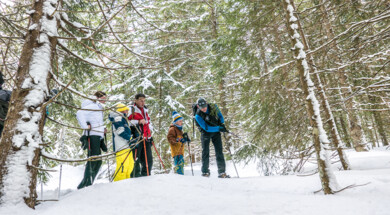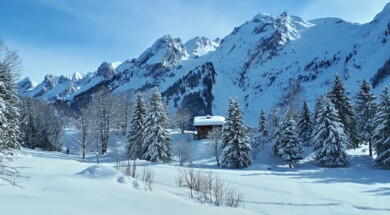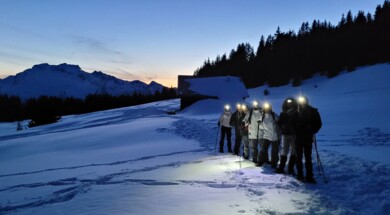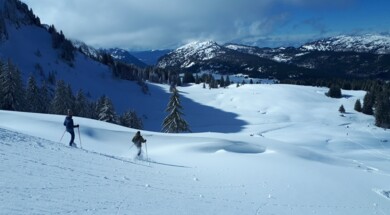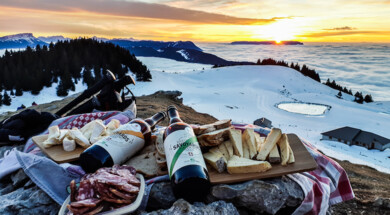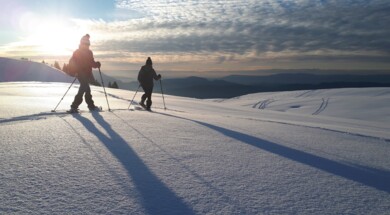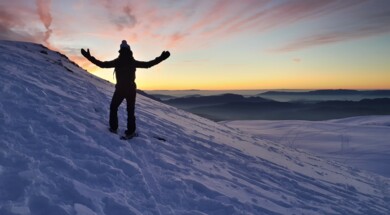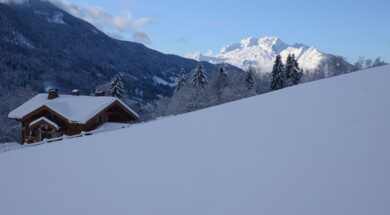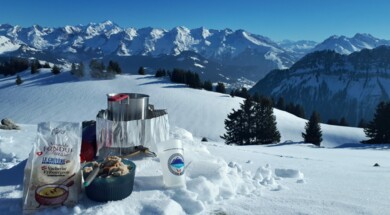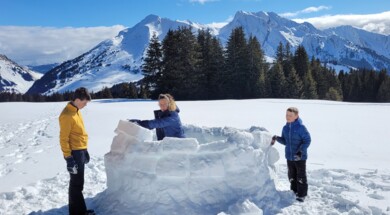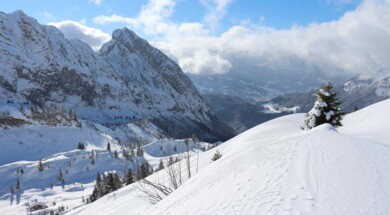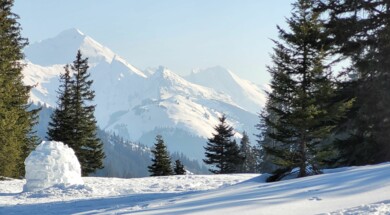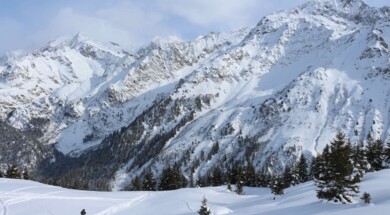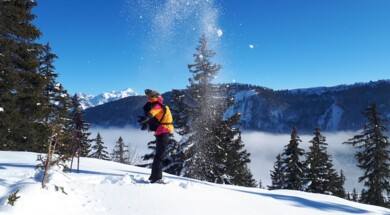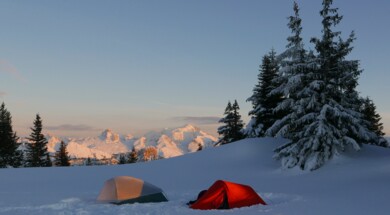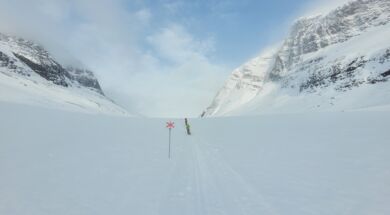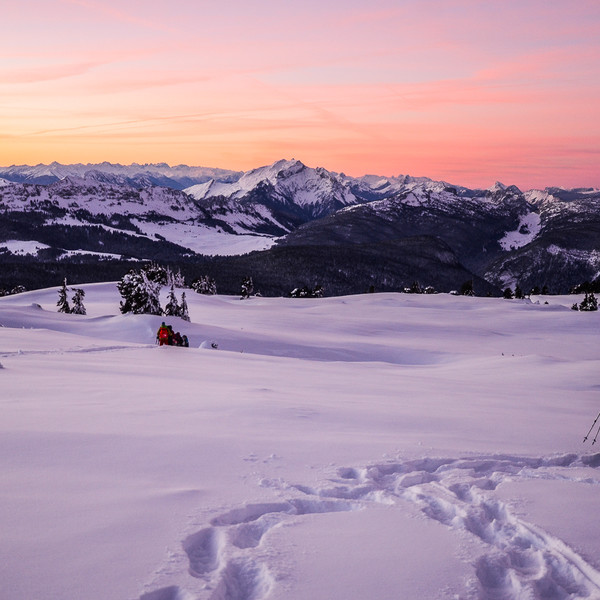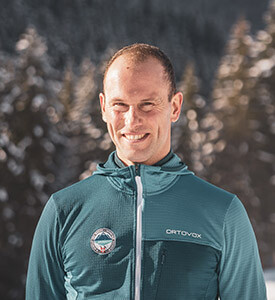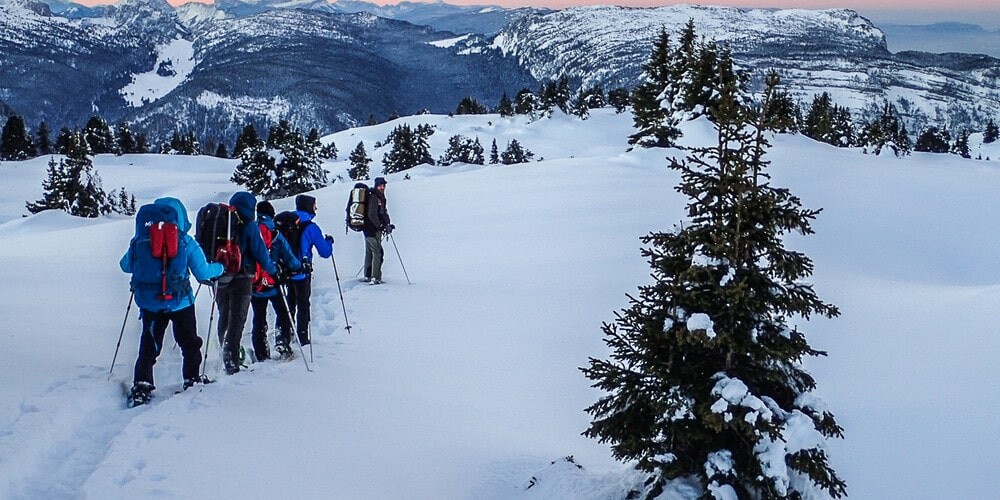What is snowshoeing?
The snowshoe is the essential tool to walk through the snowy mountains in winter without getting too deep. The activity is essentially practiced on "Nordic" style terrain, i.e. with soft and hilly relief. However, for the more sporty you can practice in steeper areas, you will have to be careful with the risks of avalanche and to be equipped with the triptych DVA/PELLE/SONDE.
In a "Nordic" setting, snowshoeing allows you to free yourself from the trails and markings because the ground is uniform and covered with this beautiful white coat. One can then leave the groomed trails and go deep into the off-trail spruce forests and feel the sensation that the first explorers had when they discovered a new territory.
Snowshoeing is a gentle practice that allows a true communion with nature because of its speed of evolution. Indeed, imagine walking in 20 cm of powder snow, in the middle of a forest on a snowy day. Your footsteps sink smoothly into the layer, the atmosphere is muffled. In wild areas, it is not rare to come across many animal tracks in the snow.
How to prepare physically for a snowshoe outing?
The preparation depends on the goal you want to achieve. Snowshoeing is not an activity you practice for competition, but rather in a contemplative spirit and in communion with nature. In terms of effort, snowshoeing is similar to hiking, however make no mistake, it can become sporty depending on the snow conditions encountered and the route you take.
In basic preparation, a gentle and regular walking/hiking activity (on flat ground and uphill) will put you in the best conditions to approach a snowshoe outing with pleasure.
In winter, other factors must be taken into account to prepare yourself as well as possible:
1 - The weight of the equipment. In addition to summer, you will have to wear snowshoes on your feet as well as heavier and more bulky clothing to face the rigors of winter.
2 - The snow. Progressing in the snow can make progress much slower and more physical. Snowshoeing on flat, groomed terrain has nothing to do with progressing in 50 cm of powder snow. The speed of evolution can be divided by 3 or even by 4 depending on the scenario (snow depth, slope). Snowshoes that "kick", i.e. if the snow sticks to the snowshoes, can add 1 to 2 kg to your strides, also making progression more difficult.
3 - Weather and cold. Winter conditions in the mountains at our latitudes can be harsh, especially at higher altitudes. The differences in temperature between day and night can be important depending on the orientation of the slopes. In these conditions, the body burns more calories to cope, so it is essential to eat and hydrate properly.
What equipment is required for a snowshoe outing?
The equipment, in the mountains and moreover in winter, is essential for your comfort and safety. It must be of good quality.
1 - The snowshoe is the basic element necessary for a snowshoe outing. There are many models with different sizes and materials. Your weight will first allow you to choose the adapted sieve that will limit your sinking in the snow. Depending on your practice and the place of exercise (plateaus or slopes), snowshoes are equipped with more or less claws and tips. These allow a better grip especially when the snow is hard.
2 - Poles are very important in snowshoeing because they will allow you to balance and propel you with more efficiency. You must take them at the right size (same size as for skiing) and especially with wide washers for a maximum bearing surface.
3 - The boots are the most important material. You must choose them that are warm, high, waterproof, insulating and sufficiently rigid for optimal comfort. The Sorel brand offers ideal models for intensive snowshoeing (from 1 to several days). For day or half-day outings, waterproof hiking boots may be suitable. However, "Moon Boot" models should be banned as they are too big and not rigid enough to adapt to the snowshoe. Boots with low stems should also be banned because the snowshoe binding strap would tighten on your ankle instead of tightening your shoe, which is not at all comfortable and could injure you over time.
How to evaluate your level in snowshoes?
Snowshoeing is an activity that does not require a great deal of technical skill. We practice it on "Nordic" grounds, i.e. soft with little slope. The difficulty of the practice lies essentially in the choice of the itinerary which is characterized by its distance and its difference in altitude, but also and especially by the snow conditions of the moment.
The mountain guides at the Annecy guide bureau are there to adapt to your level of practice and will suggest a suitable and safe itinerary so that the outing is a moment of pleasure.
It is therefore important to discuss with your mountain leader in an honest way: your experience in the mountains and your physical condition. As professionals, we will adapt and propose you an outing that suits you.
Here is an article that will allow you to correctly define your level:
-> Link to LEVELS OF DIFFICULTIES IN SNOWSHOE HIKES
Where to start snowshoeing around Annecy?
There are several areas around Annecy for beautiful snowshoe walks.
The Semnoz located in the Bauges Regional Nature Park at an altitude of 1450m is the closest ski area to Annecy (about 30 minutes drive). Access is possible by car or shuttle bus from the Annecy bus station (departure every 30 minutes). The ski area offers groomed tracks marked out for pedestrians and snowshoes. You will be able to start the activity in complete safety and in the middle of nature. The snowshoe itineraries are indicated by milestones at the start of the ski runs. You can also rent your equipment at the cross-country ski centers in the forest or on the plateau.
La Clusaz, the famous Aravis ski resort, also offers many marked snowshoe itineraries. From the confines, you can move between the magnificent chalets of the Haut-Savoyards mountain pastures facing the ski slopes of the Balme sector, a mecca for freeride skiers who love to glide in search of the abundant snow cover of the Aravis' combes.
Le Grand-Bornand, is also a beautiful destination for snowshoeing. The plateau of Samance and the valley of the bouchet are favorable sectors with gentle slopes. You will evolve in an alpine atmosphere and will be able to observe with a bit of luck the wildlife that survives on the mountain slopes.
The plateau of Glières with its beautiful forest of fir and spruce trees has a little bit of a Canadian air. As soon as you get away from the cross-country ski trails, you will find a preserved nature. The marking here is much less developed, some pedestrian itineraries are marked on the Nordic sector.


